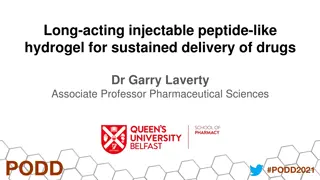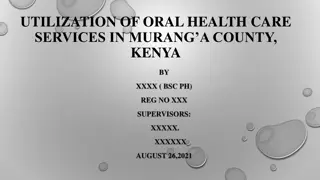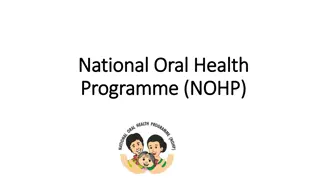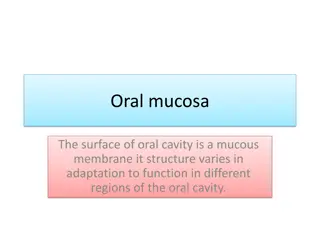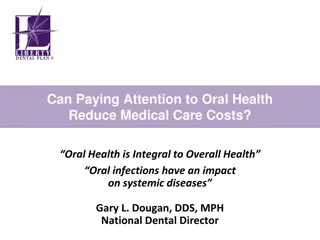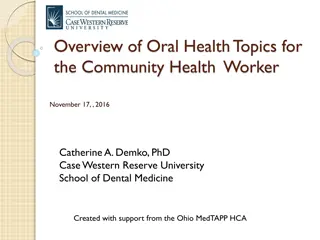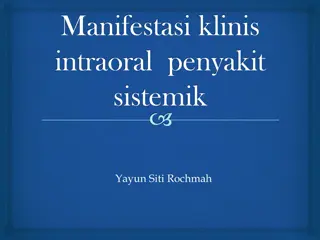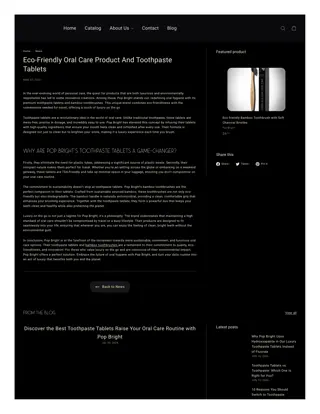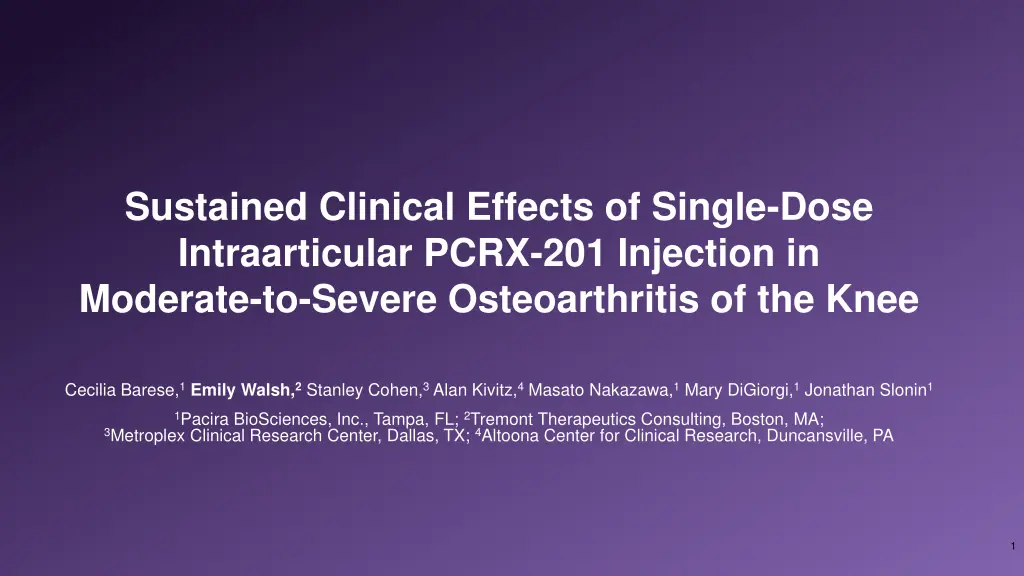
Sustained Clinical Effects of Single-Dose PCRX-201 Injection for Knee Osteoarthritis
Explore the sustained clinical effects of a single-dose intraarticular PCRX-201 injection in moderate-to-severe osteoarthritis of the knee. Discover the high need for novel treatments, the current challenges in osteoarthritis care, and the potential impact on patients and healthcare systems.
Download Presentation

Please find below an Image/Link to download the presentation.
The content on the website is provided AS IS for your information and personal use only. It may not be sold, licensed, or shared on other websites without obtaining consent from the author. If you encounter any issues during the download, it is possible that the publisher has removed the file from their server.
You are allowed to download the files provided on this website for personal or commercial use, subject to the condition that they are used lawfully. All files are the property of their respective owners.
The content on the website is provided AS IS for your information and personal use only. It may not be sold, licensed, or shared on other websites without obtaining consent from the author.
E N D
Presentation Transcript
Sustained Clinical Effects of Single-Dose Intraarticular PCRX-201 Injection in Moderate-to-Severe Osteoarthritis of the Knee Cecilia Barese,1Emily Walsh,2Stanley Cohen,3Alan Kivitz,4Masato Nakazawa,1Mary DiGiorgi,1Jonathan Slonin1 1Pacira BioSciences, Inc., Tampa, FL; 2Tremont Therapeutics Consulting, Boston, MA; 3Metroplex Clinical Research Center, Dallas, TX; 4Altoona Center for Clinical Research, Duncansville, PA 1
DISCLOSURES CB, MN, MD, and JS were or are employees of Pacira BioSciences, Inc. and may hold stock or stock options in the company. EW has received consultancy fees from Pacira BioSciences, Inc. SC is an Investigator for Pacira BioSciences, Inc. AK has consulted or been part of speakers bureaus for AbbVie, Amgen, Coval, Ecor1, Flexion, Fresenius Kabi, Gilead, Gruenthal, GSK, Halia, Horizon, Janssen, Prime, Prometheus, Sanofi-Regeneron, Selecta, Synact, Takeda-Nimbus, UCB, and XBiotech; has served on the advisory board of Fresenius Kabi, Gilead, Horizon, Takeda-Nimbus and UCB; has been a speaker for AbbVie, Lilly, Pfizer, and Sanofi-Regeneron; has been a scientific expert for Genzyme; and holds stock/stock options in Pfizer, GSK, Gilead, Novartis, and Amgen. 2
There is high need for novel OAK treatments given the lack of durable efficacy of current therapies and frequent progression to TKA Unmet Need in OAK Opportunity for Novel Therapies Lack of effective treatment makes OAK a leading cause of chronic pain and disability, affecting ~15 million patients in the United States1-3 SoC largely consists of modalities that have existed for decades, and new MoAs are needed to advance patient care Oral NSAIDs have unfavorable safety profiles given long-term adverse effects (eg, GI ulcers, serious CV events)4 Therapies providing durable pain relief could reduce disability (eg, patients with moderate-to-severe pain miss ~4 times more workdays than those with no or mild pain)10-12 Current IA injections offer only short-term relief (eg, 3-6 months),5-8and 12 months durability is considered transformational Novel treatments that reduce frequency of physician visits and surgery could lower the economic burden of OAK on the healthcare system Lack of pharmacotherapy causes many patients to progress to TKA at an average cost of ~$20,000 per procedure9 CV, cardiovascular; GI, gastrointestinal; IA, Intraarticular, MoA: mechanism of action, NSAID: nonsteroidal anti-inflammatory drug; OAK, osteoarthritis of the knee; SoC, standard of care; TKA, total knee arthroplasty. 1. GBD 2021 Osteoarthritis Collaborators. Lancet Rheumatol. 2023;5(9):e508-e522; 2. Osteoarthritis: A Serious Disease. Mount Laurel, NJ: Osteoarthritis Research Society International; 2016. Available at https://oarsi.org/oarsi-white-paper-oa-serious-disease. Accessed May 1, 2023; 3. Deshpande et al. Arthritis Care Res (Hoboken). 2016;68(12):1743-1750; 4. Vonkeman and van de Laar. Semin Arthritis Rheum. 2008;39(4):294-312; 5. Baron et al. Curr Ther Res Clin Exp. 2018;88:35-46; 6. He et al. Int J Surg. 2017;39:95-103; 7. Saltychev. Am J Phys Med Rehabil. 2020;99(7):617-625; 8. American Academy of Orthopaedic Surgeons Management of Osteoarthritis of the Knee (NonArthroplasty) Evidence-Based Clinical Practice Guideline. https://www.aaos.org/oak3cpg. Published 08/31/2021; 9. Losina et al. Arthritis Care Res (Hoboken). 2015;67(2)203-215; 10. Jackson et al. Adv Ther. 2020;37(9):3985-3999; 11. Beswick et al. BMJ Open. 2012;2(1):e000435; 12. Wylde et al. EFFORT Open Rev. 2018;3(8):461-470. 3
PCRX-201, a locally administered gene therapy with an inducible promotor, enables production of IL-1Ra in the target joint only when it is inflamed PCRX-201 Components Key PCRX-201 Strengths Avoids Gene Therapy Pitfalls High-capacity, transduction efficient HCAd with no viral coding sequences; carries the genetic code for IL-1Ra (ie, IL-1RA protein) Adenovirus Vector PCRX-201 transduces at low doses and does not insert itself into the genome, mitigating safety concerns typically associated with gene therapies Designed for Long-term Benefit IL-1 is a known inflammatory cytokine with inhibition tied to the reduction of catabolic processes in the joint that contribute to OAK progression1 PCRX-201 enables joint cells to produce IL-1Ra, providing sustained levels of the protein to yield long- term therapeutic benefit IL-1Ra Protein Production Only As Needed An NF- B promotor only turns on IL- 1Ra production in the presence of inflammation, mimicking the body s natural response to inflammation The inducible promotor allows for localized production of anti-inflammatory IL-1Ra where and when it is most needed, ensuring maintenance of joint homeostasis Inducible Promoter IL-1Ra, interleukin-1 receptor antagonist; NF- B, nuclear factor B; OAK, osteoarthritis of the knee; HCAd, high-capacity adenovirus. 1. Senter et al. Hum Gene Ther. 2022;33(9-10):541-549. 4
Methods This open-label phase 1 trial (NCT04119687) enrolled 2 cohorts Primary endpoints Safety and biodistribution Doses were assessed in cohort 1 first, followed by expansion with cohort 2 Acetaminophen was the only permitted rescue analgesic No other analgesics were permitted (other than stable doses of SSRIs, SNRIs, NSRIs, or tricyclics) Inclusion criteria Adults aged 30-80 years with moderate-to-severe knee OA K/L grade 2-4 Prior treatment failure of 2 other therapies for OA Baseline WOMAC pain score 4.0 and 9.0 of 10.0 Exploratory efficacy endpoints Patient-reported outcomes WOMAC pain WOMAC stiffness KOOS PCRX-201 dose levels: Other endpoints NAbs Structural assessments (radiograph, MRI) IL1-RA synovial fluid levels Low: 2.8E9 GC/mL Middle: 2.8E10 GC/mL High: 2.8E11 GC/mL Cohort 1:not pretreated PCRX-201 IA ultrasound- guided injection Cohort 2:steroid pretreated IA methylprednisolone 40 mg immediately before PCRX-201 administration Objective: to investigate the safety and efficacy of a single IA injection of PCRX-201 in participants with moderate-to-severe OAK in a phase 1 trial 3D, 3-dimensional; K/L, Kellgren/Lawrence; KOOS, Knee Injury and Osteoarthritis Outcome Score; IL-1RA, IL-1 receptor antagonist; MRI, magnetic resonance imaging; NAb, neutralizing antibody; NSRI, nonselective serotonin reuptake inhibitor; OA, osteoarthritis; SNRI, serotonin and norepinephrine reuptake inhibitor; SSRI, selective serotonin reuptake inhibitor; WOMAC, Western Ontario and McMaster Universities Osteoarthritis Index. 5
The Median Follow-up of 72 Participants on Study Was 52 Weeks Participant Flow Diagram 72 individuals treated 36 per cohort Part 1: SAD Part 2: Expansion Not pretreated (n=36) Steroid pretreated (n=36) Median follow-up Not pretreated - 52 (range, 17-52) weeks Low dose (n=12) Middle dose (n=16) High dose (n=8) High dose (n=8) Low dose (n=13) Middle dose (n=15) Pretreated - 52 (range, 10-52) weeks n=12 at week 52 n=14 at week 52 n=5 at week 52 n=6 at week 52 n=7 at week 52 n=12 at week 52 Discontinuations by week 52: Withdrew consent : n=8 Lost to follow-up: n=1 TEAE: n=1 Withdrawn by investigator: n=1 Death : n=1 Discontinuations by week 52: Withdrew consent*: n=4 Lost to follow-up: n=3 TEAE: n=1 SAD, single-ascending dose; TEAE, treatment-emergent adverse event; TKR, total knee replacement; WOMAC, Western Ontario and McMaster Universities Osteoarthritis Index. *2 underwent TKR, 1 did not disclose withdrawal reason, and 1 was unwilling to participate. 1 because of TEAE (index knee effusion), 1 because of inconvenience, 3 underwent TKR, 1 had treatment failure, and 2 were unwilling to participate. Not considered related to the study treatment. 6
Demographics and Baseline Characteristics Were Similar Across Cohorts Not pretreated cohort (n=36) 62.0 (58.5-67.0) 21 (58.3) Steroid pretreated cohort (n=36) 67.5 (58.5-71.5) 21 (58.3) Baseline characteristics similar across cohorts Most are female with a K/L grade of 3-4 Mean baseline WOMAC pain 6.8 in both cohorts ~75% in both cohorts had bilateral OAK Age, median (IQR), y Female, n (%) K/L grade, n (%) 2 3 4 WOMAC pain score, mean (SD) BMI, mean (SD), kg/m2 Years since primary diagnosis, mean (SD) Unilateral or bilateral OAK, n (%) Unilateral Bilateral 7 (19.4) 23 (63.9) 6 (16.7) 6.8 (1.3) 32.1 (4.2) 8.6 (8.8) 6 (16.7) 15 (41.7) 15 (41.7) 6.8 (1.1) 31.2 (4.9) 14.6 (10.9) 8 (22.2) 28 (77.8) 10 (27.8) 26 (72.2) BMI, body mass index; IQR, interquartile range; K/L, Kellgren/Lawrence; OAK, osteoarthritis of the knee; SD, standard deviation; WOMAC, Western Ontario and McMaster Universities Osteoarthritis Index. 7
PCRX-201 Was Safe and Well-Tolerated Across a 100-Fold Range of Vector Doses No related SAEs reported regardless of pretreatment or dose level Joint effusion was the most common TEAE, as shown below A total of 45 joint effusions occurred in 39 participants; of these, 44 effusions were in the index knee and 37 were deemed related to treatment by the investigator More frequent and more severe in the not pretreated cohort Similar durations in both cohorts*: range 2-165 days not pretreated, 3-111 days pretreated Summary of Participants With TEAEs Not pretreated cohort (n=36) Low dose (n=12) (n=16) (n=8) Any TEAE 9 (75.0) 15 (93.8) 8 (100) SAE 0 1 (6.3) 1 (12.5) TEAE grade 3 1 (8.3) 3 (18.8) 3 (37.5) Participants with TEAEs occurring in 10% of participants in either cohort Steroid pretreated cohort (n=36) Middle dose (n=15) 13 (86.7) 1 (6.7) 3 (20.0) Middle dose High dose Total Low dose (n=13) 11 (84.6) 1 (7.7) 2 (15.4) High dose (n=8) 8 (100.0) 2 (25.0) 2 (25.0) Total 32 (88.9) 2 (5.6) 7 (19.4) 32 (88.9) 4 (11.1) 7 (19.4) Joint effusion Arthralgia Joint swelling Headache Musculoskeletal pain 6 (50.0) 5 (41.7) 6 (50.0) 2 (16.7) 0 10 (62.5) 3 (18.8) 1 (6.3) 1 (6.3) 0 8 (100.0) 1 (12.5) 1 (12.5) 2 (25.0) 0 24 (66.7) 9 (25.0) 8 (22.2) 5 (13.9) 0 5 (38.5) 4 (30.8) 0 1 (7.7) 2 (15.4) 5 (33.3) 6 (40.0) 2 (13.3) 2 (13.3) 0 5 (62.5) 6 (75.0) 0 1 (12.5) 2 (25.0) 15 (41.7) 16 (44.4) 2 (5.6) 4 (11.1) 4 (11.1) AE, adverse event; SAE, serious adverse event; TEAE, treatment-emergent adverse event. *Effusion end was only adjudicated during scheduled visits, rather than self-reported, which may have increased the estimated duration for subjects depending on visit schedule. Including all TEAEs related and unrelated to treatment. AE grading was performed according to CTCAE v5.0. 8
EfficacyWOMAC-A Pain: 50%-75% Sustained Improvement at 52 Weeks Not pretreated Steroid pretreated Considerable improvement compared to baseline in WOMAC-A pain at all dose levels Trending dose relative in pain reduction, not statistically significant Improved pain reduction with steroid pretreatment Similar results seen with % reduction from baseline A ~50%-75% improvement from baseline across all dose levels was observed with steroid pretreatment LSM change from baseline (SEM) WOMAC IMPROVEMENT Sample size Week Low Mid High Cohort LSM, least squares mean; SEM, standard error of the mean; WOMAC, Western Ontario and McMaster Universities Osteoarthritis Index. 9
EfficacyWOMAC-B Stiffness: 50%-75% Sustained Improvement at 52 Weeks Similar improvement compared to baseline in WOMAC-B stiffness at all dose levels Trending dose relative in stiffness reduction, not statistically significant Improved stiffness reduction with steroid pretreatment Similar results seen with % reduction from baseline A ~50%-75% improvement from baseline across all dose levels was observed with steroid pretreatment Steroid pretreated Not pretreated LSM change from baseline (SEM) WOMAC IMPROVEMENT Sample size Week Low Mid High Cohort LSM, least squares mean; SEM, standard error of the mean; WOMAC, Western Ontario and McMaster Universities Osteoarthritis Index. 10
EfficacyKOOS Daily Living: 20- to 40-Point Sustained Improvement at 52 Weeks Favorable improvements in KOOS activities of daily living scores at all dose levels Trending dose relative but not statistically significant Greater improvement in steroid pretreated cohort Not pretreated Steroid pretreated KOOS IMPROVEMENT LSM change from baseline (SEM) Sample size Week Low Mid High Cohort KOOS, Knee Injury and Osteoarthritis Outcome Score; LSM, least squares mean; SEM, standard error of the mean. 11
Neutralizing Antibodies: No Impact of Baseline NAbs on Safety or Efficacy Regardless of Baseline NAb titer Baseline NAb positivity was 59%-64% in not pretreated cohorts versus 13%-64% in steroid pretreated cohorts* Not pretreated Steroid pretreated LSM % change from baseline WOMAC IMPROVEMENT in WOMAC-A No impact of baseline NAbs on WOMAC-A or WOMAC-B (not shown) regardless of baseline NAb titer No impact of baseline NAbs on effusion incidence (not shown) Sample size NAb baseline titer 0 1-499 500-5000 >5000 LSM, least squares mean; NAb, neutralizing antibody; WOMAC, Western Ontario and McMaster Universities Osteoarthritis Index. *A single clinical site predominantly enrolled the mid and high dose steroid pretreated cohort and appeared to have a 2-4-fold lower baseline rate of anti-Ad5 Nab positivity. 12
Payload Expression: Synovial Fluid IL-1RA Levels Are Elevated 1.4- to 132.9-fold After PCRX-201 Dosing Paired sample analysis offers insights Fold increase over baseline Dose Cohort Low Not Pretreated Low Not Pretreated Mid Not Pretreated Mid Not Pretreated Baseline After dose* All participants with baseline and posttreatment paired samples showed IL-1RA expression enhancement (N=4) Participant A 259.59 372.26 1.4 Participant B 1006.64 49744.08 49.4 Caveats Expressed protein is identical to endogenous NF-kB responsive promoter means expression depends on local inflammatory state Participant C 249.79 1104.32 4.4 Participant D 517.22 68759.42 132.9 13 IL-1RA, IL-1 receptor antagonist; NF- B, nuclear factor B. *All Week 4 except as noted. Sample taken at week 1.
Conclusions A single intraarticular injection of PCRX-201 had acceptable safety and sustained efficacy at all dose levels across 100-fold range up to 52 weeks at time of cutoff The steroid pretreated cohort exhibited fewer joint effusions and a ~50%-75% reduction from baseline in WOMAC/pain stiffness scores as well as greater improvements in function than the not pretreated cohort, suggesting pretreatment has a favorable impact on efficacy and tolerability and meaningful improvements in function Baseline anti-Ad5 NAbs do not appear to impact the incidence of TEAEs or improvement in WOMAC measures at any titer observed (up to >30,000) Dose-trending but no statistical dose response across a 100-fold range of vector suggests a wide range of options for dose selection Compelling phase 1 data supported PCRX-201 as the first gene therapy product candidate to receive Regenerative Medicine Advance Therapy designation in OAK from the FDA1 FDA, Food and Drug Administration; KOOS, Knee Injury and Osteoarthritis Outcome Score; NAb, neutralizing antibody; OAK, osteoarthritis of the knee; TEAE, treatment-emergent adverse event; WOMAC, Western Ontario and McMaster Universities Osteoarthritis Index. 1. Pacira BioSciences. 2024. https://investor.pacira.com/node/17121/pdf. 14
Future Directions Deeper understanding of any NAb impact on iterative and/or contralateral dosing Deeper mechanistic understanding of durability Additional dose-ranging to select the doses for pivotal studies Longer-term follow-up: 2-year long-term data now being analyzed to understand durability of pain and function improvement and impact on structural disease progression 15 NAb, neutralizing antibody.



